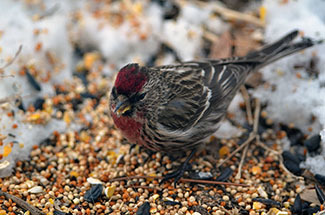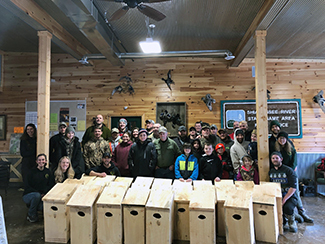MI Birds are your birds – working together for bird conservation
By ERIN ROWAN
Michigan Department of Natural Resources and Audubon Great Lakes

In the midst of a cold, sometimes dreary winter season, many people don’t think about birds, which are often considered harbingers of spring.
But a great variety of birds can be found throughout Michigan all winter long, both those that migrate from colder climates, like dark-eyed juncos and common redpolls, and those that are here year-round, such as white-breasted nuthatches and northern cardinals.
Efforts to monitor bird populations also don’t stop over the winter. Scientists need help from the public in collecting important citizen science data through winter bird counts, which help them better understand winter bird movements and population health.
Encouraging Michiganders to get involved in citizen science opportunities – and bird conservation overall – is the aim of MI Birds, a bird-focused outreach and engagement program jointly founded in 2016 by Audubon Great Lakes and the Michigan Department of Natural Resources.
The program focuses on bridging gaps between the hunting and birding communities and increasing all Michiganders’ engagement in the understanding, care and stewardship of public lands important for birds and people.
A steering committee with members from a dozen conservation organizations, some focused on game species and others on wildlife that isn’t hunted, came together to form MI Birds.
|

“Creating an environment of collaboration between birding and hunting groups is something we’ve been pushing for years, and this program has really made it happen,” said Audubon Great Lakes’ Director of Conservation Nat Miller.
MI Birds’ founding partners included Ducks Unlimited, the Ruffed Grouse Society, Pheasants Forever, the National Wild Turkey Federation, The Nature Conservancy, Detroit Audubon, Kalamazoo Nature Center, Michigan State University Extension, U.S. Fish and Wildlife Service, American Bird Conservancy and the Detroit Zoo.
These organizations, and the others MI Birds has partnered with since, are dedicated to bird conservation in Michigan.
“We are excited to have all of these conservation groups at the same table to have conversations that show how our values are aligned and how we can work together to achieve something really great,” said Holly Vaughn, Public Outreach and Engagement Unit manager for the DNR Wildlife Division. “When we are able to work together and engage our collective audiences, we can make a positive impact on bird conservation in Michigan.”
One conservation success story MI Birds has supported is the comeback of the osprey, a species of special concern that has returned in record numbers after its populations sharply declined due to pesticide use and habitat loss.
The DNR has worked closely with Osprey Watch and the Detroit Zoo to monitor osprey nests in southeast Michigan. In 2019 they joined forces with MI Birds to expand this monitoring effort, with the Adopt-A-Nest Osprey Monitoring Program across the Lower Peninsula, enlisting the help of volunteer community scientists.
“I am overwhelmed with the response we had on the adopt-a-nest program,” said Julie Oakes, the DNR wildlife biologist who manages the osprey monitoring program. “With over 280 people responding, it tells me that there are a lot of people out there who are very dedicated to helping wildlife!”
With the assistance of volunteers, 150 active nests across 29 counties were monitored in 2019.
|

While osprey and other raptors have seen increases in their populations, many other birds are experiencing population declines. A recent study published in the journal Science showed a wide-range loss of 30% of adult breeding birds across the country since 1970. Perhaps most surprising was that this loss, which includes common birds like finches, blackbirds and warblers, was observed across a wide variety of habitats.
However, this study also showed that when people work together to prioritize healthy lands and waters, birds will come back.
With the banning of DDT, increased environmental protections, improved management, and on-the-ground work of a coalition of conservation groups, raptors, woodpeckers, waterfowl and wild turkeys all have bounced back from the brink of extinction.
In 2019, with the help of 18 partner organizations, MI Birds hosted more than 30 programs and reached more than 1,200 Michiganders.
The program also successfully recruited more than 150 volunteers for a series of stewardship events, where people pitched in on projects like building nest boxes for wood ducks, and community science programs like bird-monitoring efforts.
Together, the members of its diverse group of partners help develop messages MI Birds communicates to Michigan citizens and cohost immersive guided birding tours at state game and wildlife areas they have enhanced or restored.
|

The program’s biggest presence is online, with a Facebook page more than 9,400 followers strong, and a new Instagram account with more than 500 followers. These pages feature real-time information about Michigan’s birds and community science opportunities, presented in a fun and engaging way.
MI Birds also has a website where blog posts on a variety of bird conservation topics and citizen science opportunities are shared.
“The MI Birds coalition gives all partners a platform to share their conservation successes with each other’s organizations, improving our individual and collective abilities to raise awareness of our shared goal to conserve Michigan’s birdlife,” said Ben Beaman, biologist and Adopt-A-Game-Area program coordinator with Michigan Pheasants Forever.
MI Birds is also working to raise awareness of the DNR’s important habitat work statewide, leading tours of key state game areas and other public lands, which double as Audubon Important Bird Areas. These events offer opportunities to engage the public in conversations with DNR biologists about habitat work and the species it benefits and how that work is funded through hunting license purchases.
“When people who don’t hunt understand how nongame species benefit from primarily hunting-funded work, they instantly follow-up with the question, ‘how can we help?’” Vaughn said.
“We encourage all Michiganders to purchase federal Migratory Duck Stamps, donate to the Adopt-A-Game-Area program, and volunteer as public lands stewards or community scientists. Each field trip is an opportunity to discuss this important conservation issue and brainstorm possible funding framework solutions.”
|

By elevating these discussions statewide, MI Birds stands to engage new user groups and create broader support for public lands conservation in Michigan.
Spring MI Birds events are being planned in locations around the state, including the western and central Lower Peninsula and central Upper Peninsula. Check the MI Birds Facebook page for details about upcoming events as they are announced.
“We partnered with the DNR to create MI Birds to bring people together to be advocates for birds in Michigan,” Stephanie Beilke, Audubon Great Lakes’ conservation science manager, said. “When we all come together, we are stronger and can achieve more when it comes to influencing policy and management that can help birds survive and thrive.”
MI Birds events also are places new participants might find future best friends while pursuing their interest in birds, nature and conservation.
Michigan residents who want to get involved in bird conservation this winter can take part in citizen science opportunities including:
- The Great Backyard Bird Count, Feb. 14-17. Join others around the world to take part in this event where people of all ages and birding skill levels record their bird observations in their own backyards or on nearby public lands.
- In Detroit, a MI Birds-hosted guided bird-counting tour of Belle Isle Park at 9 a.m. Saturday, Feb. 15. The tour will visit several sites along the Detroit River to count wintering birds as part of the Great Backyard Bird Count.
-
Project FeederWatch, continuing through April. Anyone interested in birds can join in this winter-long survey of birds that visit feeders at backyards, nature centers, community areas and other locations in North America.
For more information on MI Birds, visit the MI Birds website, Facebook page, Instagram page or Twitter page.
|
Check out previous Showcasing the DNR stories in our archive at Michigan.gov/DNRStories. To subscribe to upcoming Showcasing articles, sign up for free email delivery at Michigan.gov/DNR.
/Note to editors: Contact: John Pepin, Showcasing the DNR series editor, 906-226-1352. Accompanying photos and a text-only version of this story are available below for download. Caption information follows. Credit Michigan Department of Natural Resources, unless otherwise noted.
Text-only version of this story.
Banding: MI Birds hosted this bird-banding demonstration and guided bird walk at Lake St. Clair Metropark in Macomb County. (Photo by Erin Rowan)
Nuthatch: White-breasted nuthatches, like this one, are among the bird species that live in Michigan year-round.
Osprey: MI Birds has helped expand efforts to monitor Michigan osprey, a species that had been on the decline but that has made a comeback in recent years, through the Adopt-A-Nest program enlisting the help of volunteers. (Photo by Robert Black/Audubon Photography Awards)
Redpoll: Some species, like this common repoll, visit Michigan during the winter months from northern areas.
Sharonville: Michigan Pheasants Forever biologist Ben Beaman cohosted a MI Birds field trip at Sharonville State Game Area in Jackson County, which is home to ring-necked pheasants, eastern meadowlarks, grasshopper sparrows and Henslow’s sparrows. (Photo by Erin Rowan)
Sterling: A participant watches for birds during a field trip at Sterling State Park in Monroe County hosted by MI Birds and Ducks Unlimited. (Photo by Erin Rowan)
Volunteers: MI Birds helps recruit volunteers for stewardship events like this wood duck nest box-building workshop, part of Michigan United Conservation Clubs’ On the Ground volunteer habitat improvement program, at Shiawassee River State Game Area in Saginaw County last February. (Photo courtesy of Michigan United Conservation Clubs)
Woodpecker: A pileated woodpecker with young at a nest cavity. Pileated woodpeckers had disappeared from Michigan by the end of the 1800s but can now be found in woodlands and backyard bird feeders throughout the state. (Photo by Mick Thompson/flickr cc)/
|